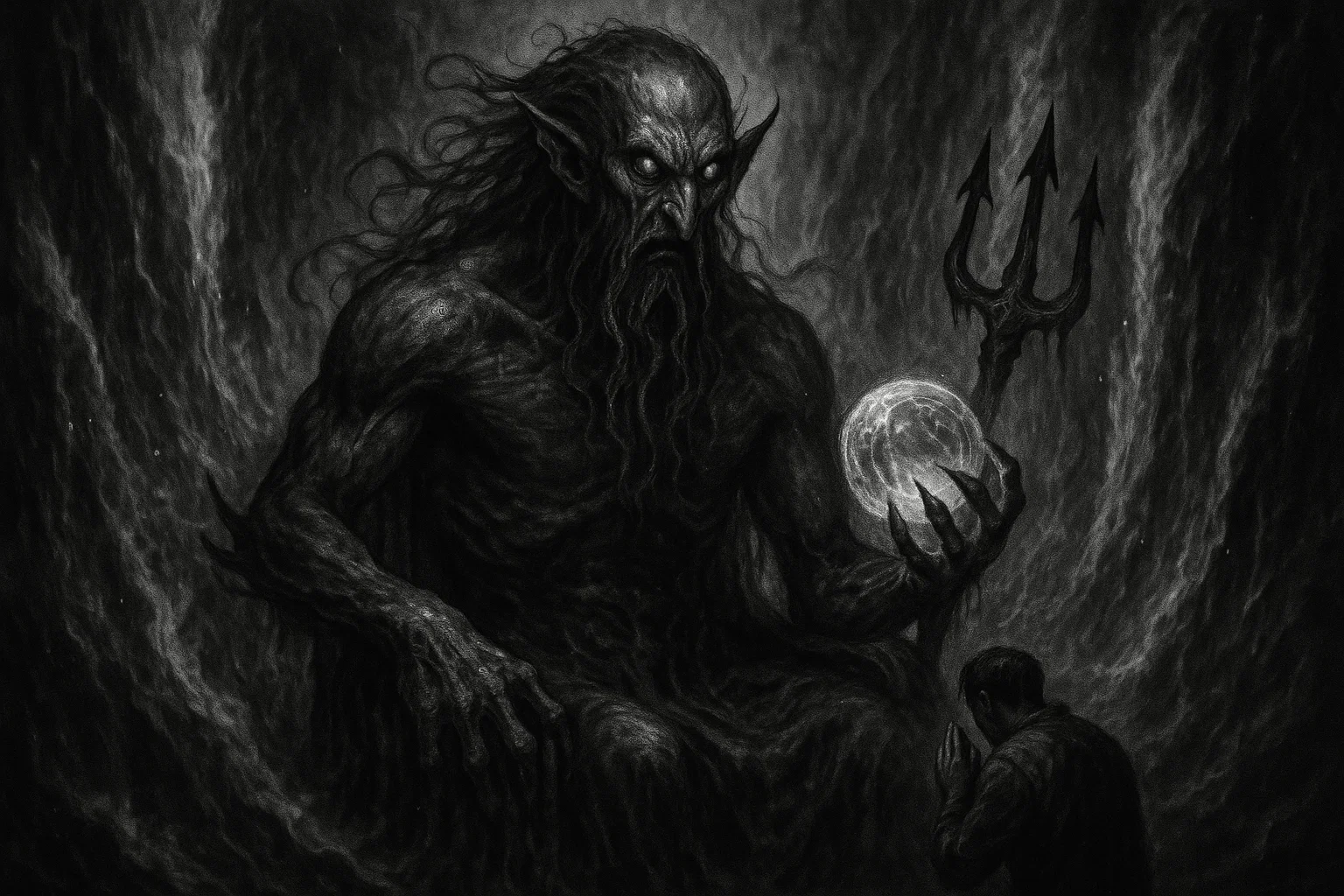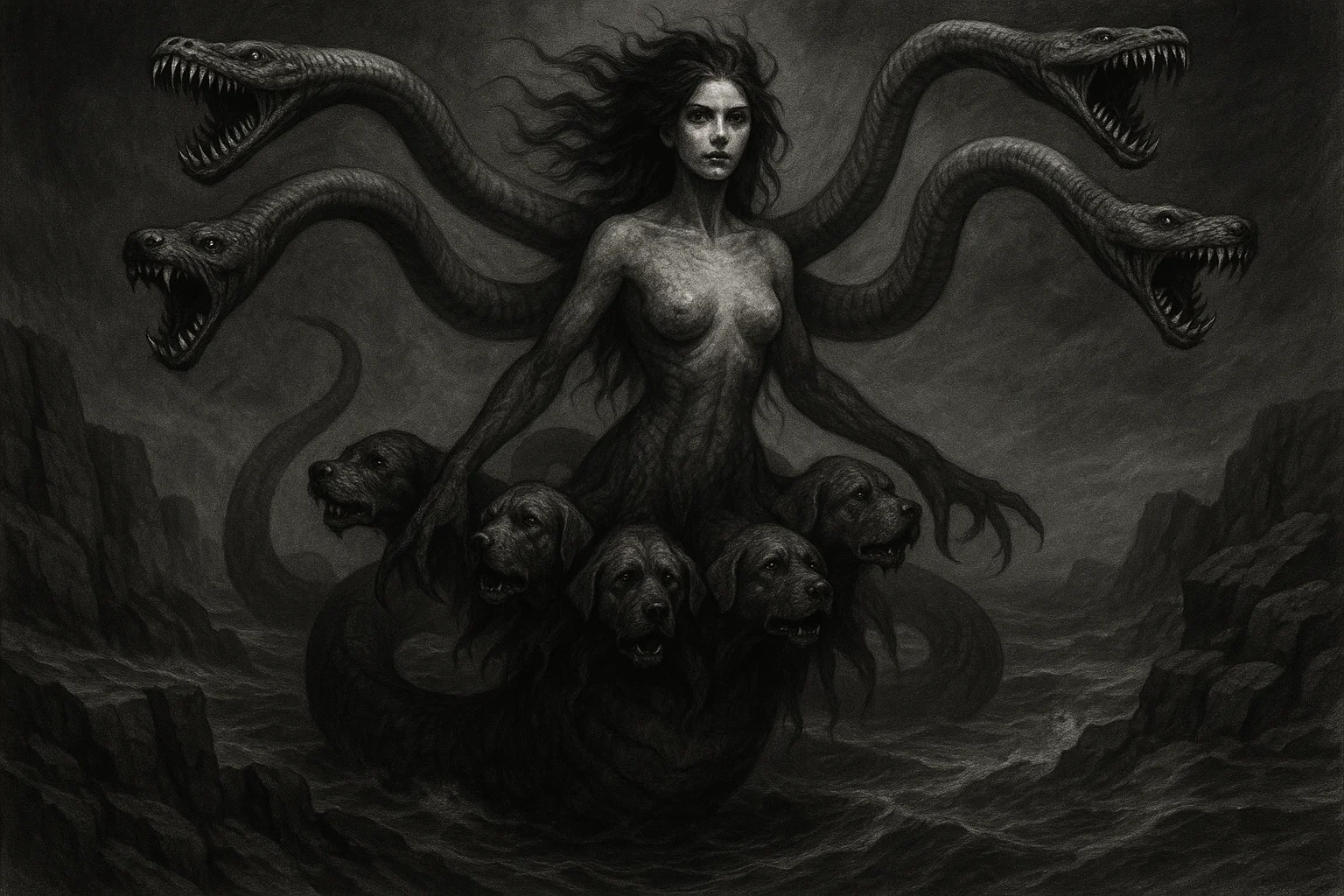Marid is a colossal force of defiance and power. Known in Islamic folklore as the mightiest among the jinn, this rebellious demon commands the churning depths of seas and storms, its azure form twisting like a tempest to challenge even the boldest summoners. Legends of the Marid echo through the ages, from the lamp-bound genies granting perilous wishes to the shadowy eavesdroppers at the gates of heaven, drawing seekers into a dance of cunning and catastrophe.
Yet beneath its watery veil lies a being of profound complexity, blending raw elemental fury with an unyielding will that defies divine order. As tales of Marid jinn weave into the fabric of Middle Eastern mythology, they invite us to explore the boundaries between mortal ambition and supernatural rebellion, where every command risks unleashing a flood of unforeseen consequences.
Summary
Key Information
| Category | Details |
|---|---|
| Name | Marid (مَارِد, mārid); Blue Jinn; Rebellious Giant; sometimes conflated with Ifrit in folklore |
| Title | Rebellious One; Giant of the Waters; Eavesdropper of Heaven; Wish-Granting Tyrant |
| Gender | Typically male, though jinn forms can shift; often depicted as imposing masculine figures |
| Role | Powerful chthonic demon; manipulator of water and storms; granter of wishes under duress; tempter through illusion and prophecy |
| Hierarchy | High-ranking among jinn devils (shayṭān); more malevolent than common devils but subordinate to Ifrit; confined to atmospheric realms in some traditions |
| Servitors | Lesser water jinn; Nasnas (half-formed hybrids); occasionally bound afrit or shaitan under compulsion |
| Superior Demon | Iblis (Shaitan, the Devil); Ifrit as a more cunning overlord in demonic pecking order |
| Powers | Control over water and weather; shape-shifting; granting wishes; superhuman strength; eavesdropping on angels for forbidden knowledge; illusion-casting |
| Appearance | Towering giant with azure or blue-tinted skin; muscular humanoid form; elongated features resembling a storm cloud; often emerges from water in humanoid or aquatic shapes |
| Etymology | From Arabic root m-r-d (مَرَدَ), meaning “rebellious” or “recalcitrant”; cognate with Hebrew “mered” (rebellion); secondary meanings include “demon” or “giant” |
| Associated Figures | King Solomon (binder of Marid); Prophet Khidr (teacher of manipulation tactics); King Sayf ibn Dhi-Yazan (adversary in epics); Ali ibn Abi Talib (narrator of confinement lore) |
| Weaknesses | Susceptible to reverse commands and trickery; bound by seals like Solomon’s ring; divine restraint (e.g., chained during Ramadan); flattery or magical compulsion |
| Opposing Angel/Saint | Archangel Gabriel (teacher of protective prayers); Prophet Muhammad (recipient of anti-Marid invocations); Saintly figures invoking Quranic wards |
| Equipment/Tools | Enchanted jars or lamps for binding; Seal of Solomon (ring for control); Water vessels for summoning; illusory treasures as lures |
| Pantheon | Islamic jinn hierarchy; Pre-Islamic Arabian spirits; Persian dev (div) influences; broader Semitic supernatural beings |
Etymology
The name Marid derives from the Arabic root m-r-d (مَرَدَ), an active participle signifying “one who rebels” or “recalcitrant spirit.” This etymological core captures the essence of defiance central to the entity’s lore, evoking a being that resists subjugation with unyielding fervor.
In classical Arabic lexicons, such as Lisan al-Arab by Ibn Manzur, the term exclusively ties to rebellion, extending to forms like māridah for the plural “rebellious giants.” Cognates appear in Hebrew as mered (rebellion) and moreḏ (rebel), highlighting Semitic linguistic threads that link the Marid to broader ancient Near Eastern concepts of cosmic insurgency.
Secondary meanings in modern Arabic dictionaries, such as Hans Wehr’s A Dictionary of Modern Written Arabic, expand it to “demon” or “giant,” reflecting its evolution from a descriptor of willful spirits to a substantive for formidable entities of the underworld. Edward Lane’s Arabic-English Lexicon further notes its application to “an evil jinnī of the most powerful class,” underscoring the Marid‘s ascent in demonic nomenclature.
This linguistic rebellion mirrors the Marid‘s mythological role, where etymology itself becomes a seal against obedience, binding the name to tales of atmospheric confinement and heavenly eavesdropping. In Persian influences, it aligns with div, giants of chaos, enriching the Marid‘s identity across cultural crossroads.
Scholars like Konstantin Jireček propose debated links to Greek Mardaitai, marauder mercenaries from Arab-Byzantine wars, suggesting historical migrations of the term into folklore. Yet, at its heart, the etymology of Marid remains a testament to linguistic rebellion, a word that, like its bearer, defies static definition.
You May Also Like: Who Is Druj Nasu? The Zoroastrian Demon of Corpse Contamination
What Does the Demon Marid Look Like?
The Marid manifests as a towering colossus, often exceeding human scale with a girth like ancient baobab trunks and limbs rippling with the fury of ocean swells. Its skin gleams in shades of deep azure or stormy blue, evoking the roiling depths from which it rises, sometimes translucent like mist-veiled waves.
Facial features elongate into a fierce, aquiline profile, with eyes like churning whirlpools that pierce illusions and souls alike. Broad shoulders and clawed hands, scaled or webbed in some visions, grasp tridents or orbs of captured rain, while a mane of liquid tendrils cascades like a perpetual waterfall.
Though capable of shape-shifting into serpentine forms or humanoid guises, the Marid‘s true visage betrays its elemental fury— a giant whose every contour screams rebellion against the dry lands of mortal dominion.
Historical and Mythological Background
The Marid‘s origins are woven through pre-Islamic Arabian lore, where it embodied the untamed spirits of desolate wastes and surging seas, predating the formalized Islamic cosmology. As jinn evolved into structured classes, the Marid solidified as a rebel archetype, its tales bridging oral epics and sacred texts to warn of hubris’s watery grave.
In Islamic tradition, the Marid emerges as a chthonic devil, confined yet scheming, its myths underscoring themes of divine order versus chaotic will. These narratives, preserved in folklore compilations, portray the Marid not as mindless evil but as a proud entity whose power tempts the unwise.
The Rebellion in Sirat Sayf ibn Dhi-Yazan
In the pre-Islamic epic Sirat Sayf ibn Dhi-Yazan, the Marid serves as a pivotal antagonist, summoned by King Sayf to unearth the legendary treasures of King Solomon, hidden beneath ancient sands. The entity, bound by ancient pacts, leads the king through labyrinthine trials, its massive form parting dunes like waves.
True to its rebellious nature, the Marid subverts commands, guiding Sayf toward peril rather than prize, flooding paths with illusory seas that drown lesser men. The king’s frustration peaks when the Marid mocks his authority, declaring, “I bow to none but the storm’s whim.”
Salvation arrives through the prophet Khidr, who reveals the art of reversal: to compel obedience, Sayf must utter the inverse of his intent, tricking the Marid into unveiling the hoard. This tale, echoed in medieval manuscripts, illustrates the Marid‘s intellectual vulnerability beneath brute force, a lesson in cunning over command.
You May Also Like: Bushyasta: The Zoroastrian Demon of Sloth and Eternal Sleep
Confinement and the Creation of Adam
A narration attributed to Ali ibn Abi Talib, recorded by Ali ibn Ibrahim al-Qummi, places the Marid at the dawn of human creation. As God prepared Adam’s form, He punished primordial beings: obliterating the malformed nasnas, veiling jinn from humanity, and chaining the “rebellious giants”—the māridah—to the atmosphere’s fringes.
These Marid, once earth-rulers of giant stature, raged against their exile, their howls manifesting as tempests that lash the skies. The tale posits their confinement as mercy’s edge; unbound, they would drown the world in vengeful floods, annihilating the fragile new race of men.
This myth, derived from early Shia exegeses, portrays the Marid as a cautionary relic of pre-Adamic chaos, its atmospheric prison serving as a divine bulwark against the tide of rebellion.
Eavesdropping at Heaven’s Gates
Medieval scholar al-Jahiz, in Kitab al-Hayawan, describes the Marid as a spirit of exceptional prowess, defined by its ascent to heaven’s doors to pilfer angelic whispers of fate. Unlike lesser jinn, the Marid lifts mountains and bends winds to eavesdrop, its stolen prophecies fueling mortal temptations.
One legend recounts a Marid descending to a desert poet, offering glimpses of unwritten verses in exchange for blood oaths of secrecy. The poet’s hubris unravels when the entity twists the knowledge into curses, drowning his tribe in prophetic madness.
Amira El-Zein’s Islam, Arabs, and the Intelligent World of the Jinn elaborates this motif, noting the Marid‘s role in nocturnal divinations, where its watery illusions mask truths as mirages, ensnaring the ambitious in cycles of false foresight.
The Chained Devils of Ramadan
A Hadith tradition, preserved in collections like those of al-Bukhari, depicts Marid alongside shaitan chained in hell’s depths during Ramadan’s sacred nights. As lunar veils descend, divine locks seal their fury, silencing storms and stilling seas for the faithful’s respite.
Yet whispers persist of unbound Marid slipping chains through clever proxies, manifesting as sudden squalls that test the devout. This cyclical myth reinforces the Marid‘s temporal leash, a reminder that even rebellion bows to celestial rhythm, though its surges threaten eternal vigilance.
These stories, spanning epics to exegeses, cement the Marid‘s mythological stature as a force of aquatic anarchy, forever testing the fragile truce between worlds.
You May Also Like: Who Is Aka Manah? The Terrifying Demon of Wicked Intention
Historical Mentions
| Text/Grimoire | Year | Description | Excerpt |
|---|---|---|---|
| Quran (Surat As-Saffat) | c. 610–632 CE | Refers to the Marid as a rebellious devil warded off by heavenly safeguards, emphasizing divine protection against its intrusions. | “And indeed, We have put the big stars as guardians, and We have adorned the lower heaven with lamps, and We have made them missiles to drive away the shayṭān mārid (rebellious devils).” (Q37:7) |
| Quran (Surah an-Nisa) | c. 610–632 CE | Condemns invocation of rebellious Satans, linking the Marid to idolatrous temptations and false deities. | “They invoke not except female [deities] besides Him, and they [in fact] invoke not except a rebellious Satan.” (Q4:117) |
| Lisan al-Arab (Ibn Manzur) | 1290 CE | Lexicon documenting the root meaning of rebellion, applying it solely to forms of defiance without supernatural expansion. | “The term only documents forms related to this general meaning of rebellion.” (Entry on m-r-d) |
| Al-Tamhîd (Ibn ‘Abd al-Barr) | 1071 CE | Classifies the Marid as a demonic entity more malevolent than ordinary devils but less potent than Ifrit, within Maliki Athari scholarship. | “The mārid is a demonic entity more malevolent than ordinary shayṭān (devils) but less powerful than an ʿifrīt.” |
| Kitab al-Hayawan (Al-Jahiz) | 9th century CE | 1984 CE (commentary on 7th-century text) | “If he succeeds in supporting an edifice, lifting a heavy weight and listening at the doors of Heaven he is a marid.” |
| Sirat Sayf ibn Dhi-Yazan | 15th–16th century CE (oral roots pre-Islamic) | Epic portraying the Marid as a disobedient guide to Solomon’s treasures, tricked via reverse commands. | “True to its rebellious nature, the mārid deliberately disobeys.” (Narrative summary in epic) |
| One Thousand and One Nights (MacNaghten edition) | 1839–1842 CE (roots 8th–14th century) | Uses Marid interchangeably with Ifrit in tales like The Fisherman, depicting a vengeful sea-bound entity. | “The latter ifrit, however, might be substituted by a marid, another type of powerful demon.” (Vol. 1, p. 20) |
| The Qur’an and Its Interpreters, Volume 1 (Mahmoud M. Ayoub) | 1984 CE (commentary on 7th century text) | Records Ali’s narration on confining rebellious giants during Adam’s creation. | “He punished humanity’s predecessors by… confining the ‘rebellious giants’ (māridah) to the atmosphere.” (p. 86) |
| Islam, Arabs, and Intelligent World of the Jinn (Amira El-Zein) | 2009 CE | Describes Marid as future-predictors ascending to eavesdrop on angels. | “A supernatural being that attempts to predict the future by ascending to the heavens and eavesdropping on angels.” (p. 143) |
Marid’s Powers and Abilities
The Marid wields dominion over aqueous realms, summoning tempests that swallow fleets or illusions that drown minds in false paradises, far beyond the generic wiles of lesser demons. Unlike common shaitan, who whispers petty vices, the Marid corrupts through grandeur—offering prophetic visions gleaned from angelic eavesdropping, tempting scholars with forbidden timelines that unravel sanity.
Its shape-shifting prowess crafts beguiling forms, from seductive sirens to colossal waves, ensnaring the greedy in webs of wish-fulfillment that twist boons into curses. This elemental mastery is corrupted by amplifying human ambition, flooding desires until they submerge virtue, as seen in epics where kings command treasures only to inherit deluges of regret.
Superhuman strength allows the Marid to upheave earth or heavens, but its true peril lies in psychological subversion: binding pacts that grant power at the cost of obedience, eroding free will like relentless tides. In folklore, such abilities target the proud, corrupting through flattery-laced servitude that masks chains of eternal resentment.
| Power/Ability | Description | Source | How It Tempts/Corrupts Humans |
|---|---|---|---|
| Water Manipulation | Summons floods, storms, or illusory seas to overwhelm foes or create deceptive oases. Unique to Marid’s aquatic essence, unlike fire-based Ifrit. | Sirat Sayf ibn Dhi-Yazan; Al-Jahiz’s Kitab al-Hayawan | Lures wanderers with mirage waters, leading to dependency on false sustenance, eroding self-reliance into idolatrous pleas for more. |
| Shape-Shifting | Assumes humanoid, animal, or elemental forms; more fluid and vast than common jinn illusions. | One Thousand and One Nights; Quran (general jinn traits) | Mimics loved ones or treasures to forge emotional bonds, corrupting through manipulated affections that breed betrayal and isolation. |
| Eavesdropping on Angels | Ascends to heaven’s edges to steal divine secrets, granting prophetic knowledge. Distinct from generic divination. | Islam, Arabs, and Intelligent World of the Jinn (El-Zein); Al-Jahiz | Offers glimpses of fate to ambitious souls, tempting with control over destiny, but twists truths into self-fulfilling dooms of hubris. |
| Wish-Granting | Fulfills desires when bound, but perverts outcomes; tied to rebellious pacts. Rare among demons. | Folklore in Arabian Nights; Pre-Islamic epics | Entices with apparent benevolence, corrupting via literal interpretations that amplify vices, turning wealth into ruinous excess. |
| Superhuman Strength | Lifts edifices or bends winds; physical might exceeding standard demonic force. | Al-Tamhîd (Ibn ‘Abd al-Barr); Kitab al-Hayawan | Overawes the powerful with feats of labor, tempting rulers to enslave it for glory, fostering tyranny that invites divine backlash. |
You May Also Like: Forneus: The Terrifying Sea Demon of the Ars Goetia
How to Counter Marid’s Powers
Countering the Marid demands ingenuity over brute force, exploiting its rebellious pride through layered deceptions rooted in sacred traditions. Primary defenses invoke Quranic wards, reciting Surah As-Saffat (37:7) to erect invisible barriers against its atmospheric incursions, chaining its form like Ramadan’s divine locks.
Magical bindings, such as the Seal of Solomon—a ring etched with interlocking stars—compel obedience, as chronicled in epics where kings trap the entity in brass vessels. To neutralize water manipulations, reverse incantations prove potent: command the opposite of intent, bidding “rise” to submerge or “calm” to unleash, turning its defiance inward.
Protective amulets inscribed with Ali’s narration of confinement fortify against eavesdropping, veiling mortal thoughts in prophetic silence. For possessions, Ruqyah exorcisms channel Archangel Gabriel’s prayers, expelling the Marid with rhythmic recitations that mimic heavenly choirs, dissolving illusions in the unyielding light of faith.
Flattery disarms its hubris during encounters, but true countermeasures blend piety with guile—offering illusory pacts that bind the binder, ensuring the Marid‘s tempests break upon shores of unassailable resolve.
Marid’s Role in the Hierarchy of Hell
Within the infernal strata of Islamic cosmology, the Marid occupies a lofty yet precarious perch among jinn devils, outranked only by the cunning Ifrit and the supreme Iblis. As articulated in Ibn ‘Abd al-Barr’s Al-Tamhîd, it surpasses ordinary shayṭān in malevolence, commanding legions of lesser water spirits and nasnas hybrids, yet its intellectual shortsightedness relegates it below fire-wreathed overlords.
Iblis, the fallen Shaitan, reigns as the ultimate superior, having marshaled Marid during primordial rebellions, as hinted in the Hadith, where chained devils include these giants during sacred moons. The Marid‘s domain spans atmospheric fringes and oceanic abysses, a liminal hell-zone where it oversees tempests as tortures for the drowned damned.
Relationships with peers fracture along elemental lines: alliances with dev-like Persian giants foster chaotic pacts, while rivalries with earth-bound ghuls erupt in subterranean skirmishes. Subordinates, like bound afrit, chafe under its watery yoke, plotting uprisings that echo the Marid‘s own defiant legacy.
In broader grimoires influenced by Arabian lore, such as pseudepigraphical Solomonic texts, the Marid functions as a mid-tier enforcer, its rank a volatile throne of waves and whispers, ever threatening to flood the hierarchy with rebellious surges.
Astrological Associations and Symbolism
The Marid aligns profoundly with watery cosmic forces, embodying Neptune’s nebulous depths and Pisces’ illusory currents, where rebellion manifests as tidal pulls against zodiacal order. Its elemental core—smokeless fire tempered by ceaseless flow—ties to water’s mutable trine, evoking Cancer’s protective shells and Scorpio’s venomous undercurrents.
Numerically, the Marid resonates with 7, the number of the Quranic jinn chapter, symbolizing veiled multiplicities, while metals like mercury (a fluid and elusive element) and stones such as aquamarine (which calms the sea) channel its essence. Colors of deep indigo and turbulent teal reflect its azure skin, warding or invoking through ritual dyes.
Zodiacal shadows loom in its aversion to fire signs, clashing with Aries’ blaze, yet harmonizing with Aquarius’ windswept intellect for prophetic alliances. These symbols—whirlpools for chaos, tridents for dominion—extend to crystals like lapis lazuli, amplifying its eavesdropping gaze under lunar eclipses.
| Association | Details | Symbolism |
|---|---|---|
| Element | Water (primary); Smokeless Fire (jinn origin) | Fluid rebellion; transformative chaos over rigid form |
| Number | 7 (Surah al-Jinn); 1 (singular defiance) | Multiplicity of hidden realms; unity in isolation |
| Metal | Mercury (quicksilver); Silver (lunar tides) | Elusiveness; reflective illusions |
| Stone/Crystal | Aquamarine; Lapis Lazuli; Moonstone | Calming tempests; heavenly insight; veiled prophecies |
| Color | Indigo; Teal; Azure Blue | Depths of deception; stormy pride |
| Zodiac | Pisces (illusion); Cancer (emotional floods); Scorpio (hidden power) | Dreamy subversion; nurturing traps; venomous pacts |
You May Also Like: Is the Downey Booger Real? Sightings, Theories, and More
Marid’s Sigil
The Marid lacks a singular, canonical sigil in traditional grimoires, its invocation relying instead on fluid, hand-drawn seals inspired by Solomonic bindings—interlocking waves encircling a rebellious trident, etched in azure ink to mimic its watery throne.
Modern occultists craft personalized sigils from its name (mārid), condensing letters into swirling vortices that capture the entity’s defiant swirl, activated through submersion in salted waters under stormy skies.
These symbols serve dual rites: summoning via chalice libations of seawater mingled with intent-spoken oaths, or protection by inscribing on shells to repel aquatic incursions. The sigil’s power lies in its mutability, dissolving like mist when charged, and embedding the Marid’s essence into the practitioner’s subconscious.
| Symbol/Item | Association/Meaning | Use in Rituals |
|---|---|---|
| Trident | Dominion over waves; threefold rebellion (earth, sea, sky) | Summoning focal point; thrust into earth to bind or release |
| Seawater | Elemental essence; purifying deception | Libation offering; bath for attunement or exorcism |
| Aquamarine | Calming fury; prophetic clarity | Amulet stone; placed on sigil for stable invocations |
| Indigo Incense | Veiled visions; atmospheric ascent | Burned to mask from angels; protective circle perimeter |
| Shell | Oceanic sanctuary; echoing commands | Inscribed vessel for reverse pacts; talisman against floods |
Comparison with Other Demons
| Demon/Entity | Origin/Pantheon | Powers | Role/Hierarchy | Key Differences from Marid |
|---|---|---|---|---|
| Ifrit | Islamic Jinn | Fire manipulation; cunning vengeance; shape-shifting into beasts | High-ranking devil; overlord to lesser shayṭān; more intellectually dominant | Fire vs. water elemental; cunning trickster over brute rebel; less bound by wishes, more vengeful autonomy |
| Ghul (Ghoul) | Pre-Islamic Arabian | Grave-robbing; illusion of feasts; shape-shifting into hyenas | Low-mid scavenger demon; solitary predator of wastelands | Earth-bound desecrator vs. atmospheric giant; tempts through hunger, not grandeur; lacks prophetic depth |
| Shaitan | Islamic (Quranic) | Whispering temptations; minor illusions; inciting sin | Infernal tempter under Iblis; legion commander of petty vices | Subtle psychological vs. overt elemental force; common devil lacking Marid’s physical might or wish-granting |
| Nasnas | Islamic Folklore | Half-formed mobility; deceptive lures; hybrid trickery | Low hybrid abomination; scout for greater jinn | Malformed weakling vs. colossal power; tempts via curiosity, not ambition; confined to terrestrial oddities |
| Si’la | Arabian Myth | Invariable shape-shifting; seductive mimicry; nocturnal hunts | Mid-tier treacherous spirit; hunter of the isolated | Fixed forms vs. fluid giants; corrupts through intimacy, not cosmic pacts; less tied to heavenly eavesdropping |
| Jann | Pre-Islamic Jinn Ancestor | Desert guardianship; elemental balance; prophetic aid | Primordial protector; influencer of historical battles | Benevolent ancestor vs. malevolent rebel; aids righteous vs. tempts all; earth-focused without aquatic fury |
| Hinn | Islamic Lesser Jinn | Animalistic instincts; minor possessions; pack behaviors | Low servitor spirits; fodder in jinn wars | Beastly underlings vs. aristocratic giants; corrupts via primal urges, not intellectual prophecies |
| Palais | Persian-Islamic Variant | Low cunning; foolable deceptions; shadow lurking | Weak trickster; easily banished minion | Dim-witted vs. proud intellect; tempts fools, while Marid ensnares the wise through reversed guile |
You May Also Like: The Cursed Phone Numbers | Horror Story
Conclusion
The Marid stands as a monumental archetype in the tapestry of Islamic folklore, a rebellious torrent that both terrifies and tantalizes with its boundless might. From the churning epics of defiant kings to the subtle wards of sacred texts, this water demon embodies the perilous allure of unchecked power, reminding us that true dominion lies not in command but in the wisdom to wield it wisely.
Yet in its azure depths, the Marid offers a mirror to human frailty—our own rebellious sparks against cosmic order, tempted by whispers of what might be. As modern seekers revisit these ancient waves, they find not mere monsters, but metaphors for navigating the undertow of ambition.
Ultimately, the legacy of the Marid endures as a call to balance: harness the storm, but never forget the shore. In understanding this giant of the unseen, we reclaim our place amid the floods, steering toward the steady light of enlightenment.







